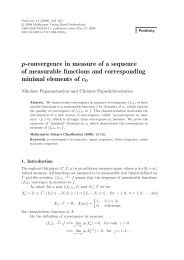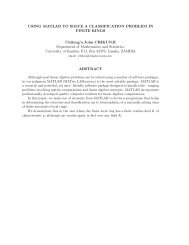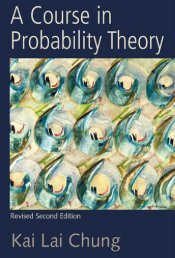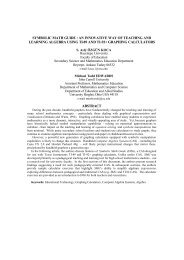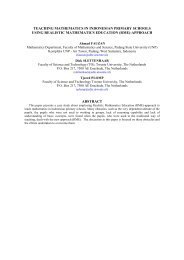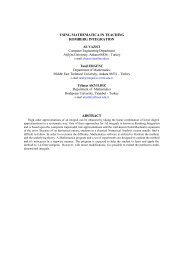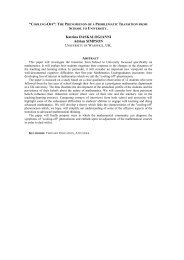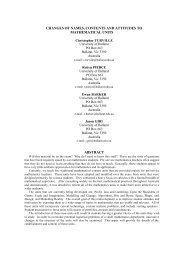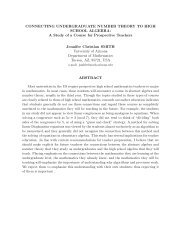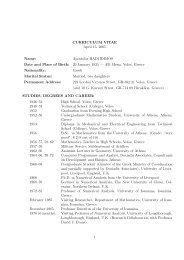Polynomial averages converge to the product of integrals
Polynomial averages converge to the product of integrals
Polynomial averages converge to the product of integrals
You also want an ePaper? Increase the reach of your titles
YUMPU automatically turns print PDFs into web optimized ePapers that Google loves.
POLYNOMIAL AVERAGES CONVERGE TO THE<br />
PRODUCT OF INTEGRALS<br />
NIKOS FRANTZIKINAKIS AND BRYNA KRA<br />
Abstract. We answer a question posed by Vitaly Bergelson, showing<br />
that in a <strong>to</strong>tally ergodic system, <strong>the</strong> average <strong>of</strong> a <strong>product</strong> <strong>of</strong><br />
functions evaluated along polynomial times, with polynomials <strong>of</strong><br />
pairwise differing degrees, <strong>converge</strong>s in L 2 <strong>to</strong> <strong>the</strong> <strong>product</strong> <strong>of</strong> <strong>the</strong><br />
<strong>integrals</strong>. Such <strong>averages</strong> are characterized by nilsystems and so we<br />
reduce <strong>the</strong> problem <strong>to</strong> one <strong>of</strong> uniform distribution <strong>of</strong> polynomial<br />
sequences on nilmanifolds.<br />
1. Introduction<br />
1.1. Bergelson’s Question. In [B96], Bergelson asked if <strong>the</strong> average<br />
<strong>of</strong> a <strong>product</strong> <strong>of</strong> functions in a <strong>to</strong>tally ergodic system (meaning that each<br />
power <strong>of</strong> <strong>the</strong> transformation is ergodic) evaluated along polynomial<br />
times <strong>converge</strong>s in L 2 <strong>to</strong> <strong>the</strong> <strong>product</strong> <strong>of</strong> <strong>the</strong> <strong>integrals</strong>. More precisely, if<br />
(X, X , µ, T) is a <strong>to</strong>tally ergodic probability measure preserving system,<br />
p 1 , p 2 , . . . , p k are polynomials taking integer values on <strong>the</strong> integers with<br />
pairwise distinct non-zero degrees, and f 1 , f 2 , . . . , f k ∈ L ∞ (µ), does<br />
lim<br />
N→∞<br />
∥ 1 N<br />
N−1<br />
∑<br />
n=0<br />
f 1 (T p 1(n) x)f 2 (T p 2(n) x) . . . f k (T p k(n) x) −<br />
k∏<br />
∫<br />
i=1<br />
∥<br />
f i dµ<br />
∥<br />
L 2 (µ)<br />
equal 0?<br />
We show that <strong>the</strong> answer <strong>to</strong> this question is positive, under slightly<br />
more general assumptions. We start with some definitions in order <strong>to</strong><br />
precisely state <strong>the</strong> <strong>the</strong>orem.<br />
An integer polynomial is a polynomial taking integer values on <strong>the</strong><br />
integers. A family <strong>of</strong> integer polynomials {p 1 (n), p 2 (n), . . . , p k (n)} is<br />
said <strong>to</strong> be independent if for all integers m 1 , m 2 , . . . , m k with at least<br />
some m j ≠ 0, j ∈ {1, 2, . . . , k}, <strong>the</strong> polynomial ∑ k<br />
j=1 m jp j (n) is not<br />
constant.<br />
We prove:<br />
The second author was partially supported by NSF grant DMS-0244994.<br />
1
2 NIKOS FRANTZIKINAKIS AND BRYNA KRA<br />
Theorem 1.1. Let (X, X , µ, T) be a <strong>to</strong>tally ergodic measure preserving<br />
probability system and assume that {p 1 (n), p 2 (n), . . . , p k (n)} is an<br />
independent family <strong>of</strong> polynomials. Then for f 1 , f 2 , . . . , f k ∈ L ∞ (µ),<br />
(1)<br />
lim<br />
N→∞<br />
∥ 1 N<br />
equals 0.<br />
N−1<br />
∑<br />
n=0<br />
f 1 (T p 1(n) x)f 2 (T p 2(n) x) . . . f k (T p k(n) x) −<br />
k∏<br />
∫<br />
i=1<br />
∥<br />
f i dµ<br />
∥<br />
L 2 (µ)<br />
The assumption that <strong>the</strong> polynomial family is independent is necessary,<br />
as can be seen by considering an irrational rotation on <strong>the</strong> circle.<br />
An ergodic rotation on a finite group with at least two elements demonstrates<br />
that <strong>the</strong> hypo<strong>the</strong>sis <strong>of</strong> <strong>to</strong>tal ergodicity is necessary; in this example,<br />
<strong>the</strong> average for any independent family with k > 1 polynomials<br />
does not <strong>converge</strong> <strong>to</strong> <strong>the</strong> <strong>product</strong> <strong>of</strong> <strong>the</strong> <strong>integrals</strong> for appropriate choice<br />
<strong>of</strong> <strong>the</strong> functions f i .<br />
If one assumes that T is weakly mixing, Bergelson [B87] showed that<br />
for all polynomial families, <strong>the</strong> limit in (1) exists and is constant. However,<br />
without <strong>the</strong> assumption <strong>of</strong> weak mixing one can easily show that<br />
<strong>the</strong> limit need not be constant, even when restricting <strong>to</strong> polynomials<br />
<strong>of</strong> degree one. For <strong>the</strong> polynomial families (n, n 2 ) and (n 2 , n 2 + n), <strong>the</strong><br />
<strong>converge</strong>nce <strong>to</strong> <strong>the</strong> <strong>product</strong> <strong>of</strong> <strong>the</strong> <strong>integrals</strong> was proved by Furstenberg<br />
and Weiss [FW96]. The existence <strong>of</strong> <strong>the</strong> limit in a <strong>to</strong>tally ergodic system<br />
for an arbitrary family <strong>of</strong> integer polynomials was shown in Host<br />
and Kra [HK02], but fur<strong>the</strong>r analysis is needed <strong>to</strong> describe <strong>the</strong> form <strong>of</strong><br />
<strong>the</strong> limit.<br />
1.2. Reduction <strong>to</strong> a problem <strong>of</strong> uniform distribution. In [HK02],<br />
Host and Kra showed that for any family <strong>of</strong> polynomials, <strong>the</strong> characteristic<br />
fac<strong>to</strong>r <strong>of</strong> <strong>the</strong> average in (1) in a <strong>to</strong>tally ergodic system is an inverse<br />
limit <strong>of</strong> nilsystems. We need a few definitions <strong>to</strong> make this statement<br />
precise.<br />
Given a group G, we denote <strong>the</strong> commuta<strong>to</strong>r <strong>of</strong> g, h ∈ G by [g, h] =<br />
g −1 h −1 gh. If A, B ⊂ G, <strong>the</strong>n [A, B] is defined <strong>to</strong> be {[a, b] : a ∈ A, b ∈<br />
B}. A group G is said <strong>to</strong> be k-step nilpotent if its (k + 1) commuta<strong>to</strong>r<br />
[G, G (k) ] is trivial. If G is a k-step nilpotent Lie group and Γ is a discrete<br />
cocompact subgroup, <strong>the</strong>n <strong>the</strong> compact space X = G/Γ is said <strong>to</strong> be a<br />
k-step nilmanifold. The group G acts on G/Γ by left translation and<br />
<strong>the</strong> translation by a fixed element a ∈ G is given by T a (gΓ) = (ag)Γ.<br />
Let µ denote <strong>the</strong> unique probability measure on X that is invariant<br />
under <strong>the</strong> action <strong>of</strong> G by left translations (called <strong>the</strong> Haar measure)<br />
and let G/Γ denote <strong>the</strong> Borel σ-algebra <strong>of</strong> G/Γ. Fixing an element
POLYNOMIAL AVERAGES CONVERGE TO THE PRODUCT OF INTEGRALS 3<br />
a ∈ G, we call <strong>the</strong> system (G/Γ, G/Γ, µ, T a ) a k-step nilsystem and call<br />
<strong>the</strong> map T a a nilrotation.<br />
A fac<strong>to</strong>r <strong>of</strong> <strong>the</strong> measure preserving system (X, X , µ, T) is a measure<br />
preserving system (Y, Y, ν, S) so that <strong>the</strong>re exists a measure preserving<br />
map π : X → Y taking µ <strong>to</strong> ν and such that S ◦ π = π ◦ T. In a slight<br />
abuse <strong>of</strong> terminology, when <strong>the</strong> underlying measure space is implicit<br />
we call S a fac<strong>to</strong>r <strong>of</strong> T.<br />
In this terminology, Host and Kra’s result means that <strong>the</strong>re exists<br />
a fac<strong>to</strong>r (Z, Z, m) <strong>of</strong> X, where Z denotes <strong>the</strong> Borel σ-algebra <strong>of</strong> Z<br />
and m its Haar measure, so that <strong>the</strong> action <strong>of</strong> T on Z is an inverse<br />
limit <strong>of</strong> nilsystems and fur<strong>the</strong>rmore, whenever E(f j |Z) = 0 for some<br />
j ∈ {1, 2, . . . , k}, <strong>the</strong> average in (1) is itself 0. Since an inverse limits<br />
<strong>of</strong> nilsystems can be approximated arbitrarily well by a nilsystem, it<br />
suffices <strong>to</strong> verify Theorem 1.1 for nilsystems. Moreover, since measurable<br />
functions can be approximated arbitrarily well in L 2 by continuous<br />
functions, Theorem 1.1 is equivalent <strong>to</strong> <strong>the</strong> following generalization <strong>of</strong><br />
Weyl’s polynomial uniform distribution <strong>the</strong>orem (see Section 4 for <strong>the</strong><br />
statement <strong>of</strong> Weyl’s Theorem):<br />
Theorem 1.2. Let X = G/Γ be a nilmanifold, (G/Γ, G/Γ, µ, T a ) a<br />
nilsystem and suppose that <strong>the</strong> nilrotation T a is <strong>to</strong>tally ergodic. If<br />
{p 1 (n), p 2 (n), . . . , p k (n)} is an independent polynomial family, <strong>the</strong>n for<br />
almost every x ∈ X <strong>the</strong> sequence (a p 1(n) x, a p 2(n) x, . . . , a p k(n) x) is uniformly<br />
distributed in X k .<br />
If G is connected, we can reduce Theorem 1.2 <strong>to</strong> a uniform distribution<br />
problem that is easily verified using <strong>the</strong> standard uniform distribution<br />
<strong>the</strong>orem <strong>of</strong> Weyl. The general (not necessarily connected) case<br />
is more subtle. Using a result <strong>of</strong> Leibman [L02], in Section 2, we reduce<br />
<strong>the</strong> problem <strong>to</strong> studying <strong>the</strong> action <strong>of</strong> a polynomial sequence on a fac<strong>to</strong>r<br />
space with abelian identity component. The key step (Section 3) is<br />
<strong>the</strong>n <strong>to</strong> prove that nilrotations acting on such spaces are isomorphic <strong>to</strong><br />
affine transformations on some finite dimensional <strong>to</strong>rus. In Section 4,<br />
we complete <strong>the</strong> pro<strong>of</strong> by checking <strong>the</strong> result for affine transformations.<br />
2. Reduction <strong>to</strong> an abelian connected component<br />
Suppose that G is a nilpotent Lie group and Γ is a discrete, cocompact<br />
subgroup. Throughout, we let G 0 denote <strong>the</strong> connected component<br />
<strong>of</strong> <strong>the</strong> identity element and denote <strong>the</strong> identity element by e.<br />
with a 1 , a 2 , . . . , a k ∈ G and<br />
p 1 , p 2 , . . . , p k integer polynomials is called a polynomial sequence in G.<br />
We are interested in studying uniform distribution properties <strong>of</strong> polynomial<br />
sequences on <strong>the</strong> nilmanifold X = G/Γ.<br />
A sequence g(n) = a p 1(n)<br />
1 a p 2(n)<br />
2 . . . a p k(n)<br />
k
4 NIKOS FRANTZIKINAKIS AND BRYNA KRA<br />
Leibman [L02] showed that <strong>the</strong> uniform distribution <strong>of</strong> a polynomial<br />
sequence in a connected nilmanifold reduces <strong>to</strong> uniform distribution in<br />
a certain fac<strong>to</strong>r:<br />
Theorem. [Leibman] Let X = G/Γ be a connected nilmanifold and<br />
let g(n) = a p 1(n)<br />
1 a p 2(n)<br />
2 . . . a p k(n)<br />
k<br />
be a polynomial sequence in G. Let Z =<br />
X/[G 0 , G 0 ] and let π: X → Z be <strong>the</strong> natural projection. If x ∈ X <strong>the</strong>n<br />
{g(n)x} n∈Z is uniformly distributed in X if and only if {g(n)π(x)} n∈Z<br />
is uniformly distributed in Z.<br />
We remark that if G is connected, <strong>the</strong>n <strong>the</strong> fac<strong>to</strong>r X/[G 0 , G 0 ] is an<br />
abelian group. However, this does not hold in general as <strong>the</strong> following<br />
examples illustrate:<br />
Example 1. On <strong>the</strong> space G = Z×R 2 , define multiplication as follows:<br />
if g 1 = (m 1 , x 1 , x 2 ) and g 2 = (n 1 , y 1 , y 2 ), let<br />
g 1 · g 2 = (m 1 + n 1 , x 1 + y 1 , x 2 + y 2 + m 1 y 1 ).<br />
Then G is a 2-step nilpotent group and G 0 = {0} × R 2 is abelian. The<br />
discrete subgroup Γ = Z 3 is cocompact and X = G/Γ is connected.<br />
Moreover, [G 0 , G 0 ] = {e} and so X/[G 0 , G 0 ] = X.<br />
Example 2. On <strong>the</strong> space G = Z×R 3 , define multiplication as follows:<br />
if g 1 = (m 1 , x 1 , x 2 , x 3 ) and g 2 = (n 1 , y 1 , y 2 , y 3 ), let<br />
g 1 · g 2 = (m 1 + n 1 , x 1 + y 1 , x 2 + y 2 + m 1 y 1 , x 3 + y 3 + m 1 y 2 + 1 2 m2 1 y 1).<br />
Then G is a 3-step nilpotent group and G 0 = {0} × R 3 is abelian.<br />
The discrete subgroup Γ = Z 3 × (Z/2) is cocompact and X = G/Γ is<br />
connected. Again, X/[G 0 , G 0 ] = X.<br />
We use Leibman’s <strong>the</strong>orem <strong>to</strong> reduce <strong>the</strong> problem on uniform distribution<br />
<strong>to</strong> <strong>the</strong> case that G 0 is abelian:<br />
Proposition 2.1. Theorem 1.2 follows if it holds for all nilsystems<br />
(G/Γ, G/Γ, µ, T a ) with G 0 abelian and T a <strong>to</strong>tally ergodic.<br />
Pro<strong>of</strong>. Given a ∈ G and x ∈ X = G/Γ, let a 1 = (a, e, . . . , e), a 2 =<br />
(e, a, e, . . . , e), . . . , a k = (e, e, . . . , a) ∈ G k , ˜x = (x, . . . , x) ∈ X k , and<br />
g(n) = T p 1(n)<br />
a 1 T p 2(n)<br />
a 2 · · · T p k(n)<br />
a k<br />
. We need <strong>to</strong> check that for µ-a.e. x ∈ X<br />
<strong>the</strong> polynomial sequence g(n)˜x is uniformly distributed in X k . By<br />
Leibman’s Theorem, it suffices <strong>to</strong> check that g(n)π(˜x) is uniformly<br />
distributed in <strong>the</strong> nilmanifold Z k , where Z = X/[G 0 , G 0 ] and π: G →<br />
G/[G 0 , G 0 ] is <strong>the</strong> natural projection. Since (G/[G 0 , G 0 ]) 0 is abelian and<br />
a fac<strong>to</strong>r <strong>of</strong> a <strong>to</strong>tally ergodic system is <strong>to</strong>tally ergodic, <strong>the</strong> statement<br />
follows.<br />
□
POLYNOMIAL AVERAGES CONVERGE TO THE PRODUCT OF INTEGRALS 5<br />
3. Reduction <strong>to</strong> an affine transformation on a <strong>to</strong>rus<br />
We reduce <strong>the</strong> problem on uniform distribution (Theorem 1.2) <strong>to</strong><br />
studying an affine transformation on a <strong>to</strong>rus. If G is a group <strong>the</strong>n a map<br />
T : G → G is said <strong>to</strong> be affine if T(g) = bA(g) for an endomorphism A<br />
<strong>of</strong> G and some b ∈ G. The endomorphism A is said <strong>to</strong> be unipotent if<br />
<strong>the</strong>re exists n ∈ N so that so that (A − Id) n = 0. In this case we say<br />
that <strong>the</strong> affine transformation T is a unipotent affine transformation.<br />
Proposition 3.1. Let X = G/Γ be a connected nilmanifold such that<br />
G 0 is abelian. Then any nilrotation T a (x) = ax defined on X with <strong>the</strong><br />
Haar measure µ is isomorphic <strong>to</strong> a unipotent affine transformation on<br />
some finite dimensional <strong>to</strong>rus.<br />
Pro<strong>of</strong>. First observe that for every g ∈ G, <strong>the</strong> subgroup g −1 G 0 g is both<br />
open and closed in G so g −1 G 0 g = G 0 . Hence, G 0 is a normal subgroup<br />
<strong>of</strong> G. Similarly, since G 0 Γ is both open and closed in G, we have that<br />
(G 0 Γ)/Γ is open and closed in X. Since X is connected, X = (G 0 Γ)/Γ<br />
and so G = G 0 Γ.<br />
We claim that Γ 0 = Γ ∩ G 0 is a normal subgroup <strong>of</strong> G. Let γ 0 ∈ Γ 0<br />
and g = g 0 γ, where g 0 ∈ G 0 and γ ∈ Γ. Since G 0 is normal in G, we<br />
have that g −1 γ 0 g ∈ G 0 . Moreover,<br />
g −1 γ 0 g = γ −1 g −1<br />
0 γ 0g 0 γ = γ −1 γ 0 γ ∈ Γ,<br />
<strong>the</strong> last equality being valid since G 0 is abelian. Hence, g −1 γ 0 g ∈ Γ 0<br />
and Γ 0 is normal in G.<br />
Therefore we can substitute G/Γ 0 for G and Γ/Γ 0 for Γ; <strong>the</strong>n X =<br />
(G/Γ 0 )/(Γ/Γ 0 ). So we can assume that G 0 ∩ Γ = {e}. Note that we<br />
now have that G 0 is a connected compact abelian Lie group and so is<br />
isomorphic <strong>to</strong> some finite dimensional <strong>to</strong>rus T d .<br />
Every g ∈ G is uniquely representable in <strong>the</strong> form g = g 0 γ, with<br />
g 0 ∈ G 0 , γ ∈ Γ. The map φ: X → G 0 , given by φ(gΓ) = g 0 is a well<br />
defined homeomorphism. Since φ(hgΓ) = hφ(gΓ) for any h ∈ G 0 , <strong>the</strong><br />
measure φ(µ) on G 0 is invariant under left translations. Thus φ(µ) is<br />
<strong>the</strong> Haar measure on G 0 . If a = a 0 γ, g = g 0 γ ′ with a 0 , g 0 ∈ G 0 and<br />
γ, γ ′ ∈ Γ, <strong>the</strong>n agΓ = a 0 γg 0 γ −1 Γ. Since γg 0 γ −1 ∈ G 0 , we have that<br />
φ(agΓ) = a 0 γg 0 γ −1 . Hence φ conjugates T a <strong>to</strong> T ′ a: G 0 → G 0 defined by<br />
T ′ a (g 0) = φT a φ −1 = a 0 γg 0 γ −1 .<br />
Since G 0 is abelian this is an affine map; its linear part g 0 ↦→ γg 0 γ −1<br />
is unipotent since G is nilpotent. Letting ψ: G 0 → T d denote <strong>the</strong><br />
isomorphism between G 0 and T d , we have that T a is isomorphic <strong>to</strong> <strong>the</strong><br />
unipotent affine transformation S = ψT aψ ′ −1 acting on T d . □
6 NIKOS FRANTZIKINAKIS AND BRYNA KRA<br />
We illustrate this with <strong>the</strong> examples <strong>of</strong> <strong>the</strong> previous section:<br />
Example 3. Let X be as in Example 1 and let a = (m 1 , a 1 , a 2 ). Since<br />
G 0 /Γ 0 = T 2 we see that T a is isomorphic <strong>to</strong> <strong>the</strong> unipotent affine transformation<br />
S : T 2 → T 2 given by<br />
S(x 1 , x 2 ) = (x 1 + a 1 , x 2 + m 1 x 1 + a 2 ).<br />
Example 4. Let X be as in Example 2 and a = (m 1 , a 1 , a 2 , a 3 ). Since<br />
G 0 /Γ 0 = R 3 /(Z 2 ×Z/2), and ψ: G 0 /Γ 0 → T 3 defined by ψ(x 1 , x 2 , x 3 ) =<br />
(x 1 , x 2 , 2x 3 ) is an isomorphism, we see that T a is isomorphic <strong>to</strong> <strong>the</strong><br />
unipotent affine transformation S: T 3 → T 3 given by<br />
S(x 1 , x 2 , x 3 ) = (x 1 + a 1 , x 2 + m 1 x 1 + a 2 , x 3 + 2m 1 x 2 + m 2 1x 1 + 2a 3 ).<br />
Proposition 3.2. Theorem 1.2 follows if it holds for all nilsystems<br />
(G/Γ, G/Γ, µ, T a ) such that T a is isomorphic <strong>to</strong> an ergodic, unipotent,<br />
affine transformation on some finite dimensional <strong>to</strong>rus.<br />
Pro<strong>of</strong>. We first note that since X = G/Γ admits a <strong>to</strong>tally ergodic<br />
nilrotation T a , it must be connected. Indeed, let X 0 be <strong>the</strong> identity<br />
component <strong>of</strong> X. Since X is compact, it is a disjoint union <strong>of</strong> d copies<br />
<strong>of</strong> translations <strong>of</strong> X 0 for some d ∈ N. Since a permutes <strong>the</strong>se copies,<br />
a d preserves X 0 . By assumption <strong>the</strong> translation by T a d = Ta d is ergodic<br />
and so X 0 = X.<br />
By Proposition 2.1 we can assume that G 0 is abelian. Since X is<br />
connected, <strong>the</strong> result follows from Proposition 3.1.<br />
□<br />
4. Uniform distribution for an affine transformation<br />
We are left with showing that Theorem 1.2 holds when <strong>the</strong> nilsystem<br />
is isomorphic <strong>to</strong> an ergodic, unipotent, affine system on a finite dimensional<br />
<strong>to</strong>rus. Before turning in<strong>to</strong> <strong>the</strong> pro<strong>of</strong>, note that if G is connected<br />
<strong>the</strong>n <strong>the</strong> uniform distribution property <strong>of</strong> Theorem 1.2 holds for every<br />
x ∈ X. However, this does not hold in general. We illustrate this with<br />
<strong>the</strong> following example:<br />
Example 5. We have seen that <strong>the</strong> nilrotation <strong>of</strong> Example 1 is isomorphic<br />
<strong>to</strong> <strong>the</strong> affine transformation S : T 2 → T 2 given by<br />
S(x 1 , x 2 ) = (x 1 + a 1 , x 2 + m 1 x 1 + a 2 ).<br />
If m 1 = 2 and a 1 = a 2 = a is irrational <strong>the</strong>n S is <strong>to</strong>tally ergodic and<br />
S n (x 1 , x 2 ) = (x 1 + na, x 2 + 2nx 1 + n 2 a). Then<br />
(<br />
S n (0, 0), S n2 (0, 0) ) = (na, n 2 a, n 2 a, n 4 a)
POLYNOMIAL AVERAGES CONVERGE TO THE PRODUCT OF INTEGRALS 7<br />
is not uniformly distributed on T 4 . On <strong>the</strong> o<strong>the</strong>r hand<br />
(<br />
S n (x 1 , x 2 ), S n2 (x 1 , x 2 ) ) =<br />
(x 1 + na, x 2 + 2nx 1 + n 2 a, x 1 + n 2 a, x 2 + 2n 2 x 1 + n 4 a, )<br />
is uniformly distributed on T 4 as long as a and x 1 are rationally independent.<br />
The main <strong>to</strong>ol used in <strong>the</strong> pro<strong>of</strong> <strong>of</strong> Theorem 1.2 is <strong>the</strong> following<br />
classic <strong>the</strong>orem <strong>of</strong> Weyl [W16] on uniform distribution:<br />
Theorem. [Weyl] (i) Let a n ∈ R d . Then a n is uniformly distributed<br />
in T d if and only if<br />
1<br />
N∑<br />
lim e 2πim·an = 0<br />
N→∞ N<br />
n=1<br />
for every nonzero m ∈ Z d , where m · a n denotes <strong>the</strong> inner <strong>product</strong> <strong>of</strong><br />
m and a n .<br />
(ii) If a n = p(n) where p is a real valued polynomial with at least<br />
one nonconstant coefficient irrational <strong>the</strong>n<br />
1<br />
N∑<br />
lim e 2πian = 0.<br />
N→∞ N<br />
n=1<br />
Before turning <strong>to</strong> <strong>the</strong> pro<strong>of</strong> <strong>of</strong> Theorem 1.2, we prove a lemma that<br />
simplifies <strong>the</strong> computations:<br />
Lemma 4.1. Let T : T d → T d be defined by T(x) = Ax+b, where A is<br />
a d × d unipotent integer matrix and b ∈ T d . Assume fur<strong>the</strong>rmore that<br />
T is ergodic. Then T is a fac<strong>to</strong>r <strong>of</strong> an ergodic affine transformation<br />
S: T d → T d , where S = S 1 × S 2 × · · · × S s and for r = 1, 2, . . . , s,<br />
S r : T dr → T dr ( ∑ s<br />
r=1 d r = d) has <strong>the</strong> form<br />
S r (x r1 , x r2 , . . . , x rdr ) = (x r1 + b r , x r2 + x r1 , . . . , x rdr + x rdr−1)<br />
for some b r ∈ T.<br />
Pro<strong>of</strong>. Let J be <strong>the</strong> Jordan canonical form <strong>of</strong> A with Jordan blocks J r<br />
<strong>of</strong> dimension d r for r = 1, 2, . . . , s. Since A is unipotent, all diagonal<br />
entries <strong>of</strong> J are equal <strong>to</strong> 1. There exists a matrix P with rational<br />
entries such that P A = JP. After multiplying P by an appropriate<br />
integer, we can assume that it <strong>to</strong>o has integer entries. So P defines an<br />
endomorphism P : T d → T d such that P T = SP, where S : T d → T d is<br />
given by S(x) = J(x) + c for c = P(b). Hence, T is a fac<strong>to</strong>r <strong>of</strong> S. By<br />
making a change <strong>of</strong> variables x → x + a for some suitable a ∈ T d , we<br />
can assume that S has <strong>the</strong> advertised form.
8 NIKOS FRANTZIKINAKIS AND BRYNA KRA<br />
It remains <strong>to</strong> show that S is ergodic. Since J is unipotent, using<br />
a <strong>the</strong>orem <strong>of</strong> Hahn ([H63], Theorem 4) we get that ergodicity <strong>of</strong> S is<br />
equivalent <strong>to</strong> showing that for every nontrivial character χ in <strong>the</strong> dual<br />
<strong>of</strong> T d we have <strong>the</strong> implication<br />
χ(Jx) = χ(x) for every x ∈ T d ⇒ χ(c) ≠ 1.<br />
Suppose that χ(Jx) = χ(x). Using <strong>the</strong> relation P A = JP we get that<br />
χ ′ (Ax) = χ ′ (x) where χ ′ (x) = χ(P x). Since T(x) = Ax + b is assumed<br />
<strong>to</strong> be ergodic, again using Hahn’s <strong>the</strong>orem we get that χ ′ (b) ≠ 1. The<br />
relation P A = JP implies that χ(c) ≠ 1 and <strong>the</strong> pro<strong>of</strong> is complete. □<br />
Pro<strong>of</strong> <strong>of</strong> Theorem 1.2. By Proposition 3.2 it suffices <strong>to</strong> verify <strong>the</strong> uniform<br />
distribution property for all ergodic, unipotent, affine transformations<br />
on T d . First observe that relation (1) <strong>of</strong> Theorem 1.1 is preserved<br />
when passing <strong>to</strong> fac<strong>to</strong>rs. Hence, using Lemma 4.1 we can assume that<br />
T = T 1 × T 2 × · · · × T s , where T r : T dr → T dr ( ∑ s<br />
r=1 d r = d) is given by<br />
T r (x r1 , x r2 , . . . , x rdr ) = (x r1 + b r , x r2 + x r1 , . . . , x rdr + x rdr−1),<br />
for r = 1, 2, . . . , s. Since T is ergodic <strong>the</strong> set {b 1 , b 2 , . . . , b s } is rationally<br />
independent. For convenience, set x r0 = b r for r = 1, 2, . . . s.<br />
We claim that if x is chosen so that <strong>the</strong> set C = {x rj : 1 ≤ r ≤<br />
s, 0 ≤ j ≤ d r } is rationally independent, <strong>the</strong>n <strong>the</strong> polynomial sequence<br />
g(n)˜x = (T p1(n) x, T p2(n) x, . . . , T pk(n) x) is uniformly distributed on T dk<br />
(we include x rdr in C only for simplicity). To see this we use <strong>the</strong> first<br />
part <strong>of</strong> Weyl’s <strong>the</strong>orem; letting Q rjl (n) denote <strong>the</strong> j-th coordinate <strong>of</strong><br />
x and<br />
T p l(n)<br />
r<br />
(2) R(n) = ∑ r,j,l<br />
m rjl Q rjl (n)<br />
where {m rjl : 1 ≤ r ≤ s, 1 ≤ j ≤ d r , 1 ≤ l ≤ k} are integers, not all <strong>of</strong><br />
<strong>the</strong>m zero, it suffices <strong>to</strong> check that<br />
1<br />
(3) lim<br />
N→∞ N<br />
N∑<br />
e 2πiR(n) = 0.<br />
n=1<br />
To prove (3) we use <strong>the</strong> second part <strong>of</strong> Weyl’s <strong>the</strong>orem; it suffices <strong>to</strong><br />
show that <strong>the</strong> polynomial R(n) has at least one nonconstant coefficient<br />
irrational. We compute<br />
(<br />
pl (n)<br />
(4) Q rjl (n) = x rj +<br />
1<br />
)<br />
x rj−1 + · · · +<br />
( )<br />
pl (n)<br />
x r1 +<br />
j − 1<br />
(<br />
pl (n)<br />
j<br />
)<br />
x r0 .
POLYNOMIAL AVERAGES CONVERGE TO THE PRODUCT OF INTEGRALS 9<br />
We can put R(n) in <strong>the</strong> form<br />
(5) R(n) = ∑ r,j<br />
R rj (n)x rj ,<br />
where R rj are integer polynomials and 1 ≤ r ≤ s, 0 ≤ j ≤ d r . This<br />
representation is unique since <strong>the</strong> x rj are rationally independent. So it<br />
remains <strong>to</strong> show that some R rj is nonconstant. To see this, choose any<br />
r 0 such that m r0 jl ≠ 0 for some j, l, and define j 0 <strong>to</strong> be <strong>the</strong> maximum<br />
1 ≤ j ≤ d r0 such that m r0 jl ≠ 0 for some 1 ≤ l ≤ k. We show that<br />
R r0 ,j 0 −1 is nonconstant. By <strong>the</strong> definition <strong>of</strong> j 0 we have m r0 jl = 0 for<br />
j > j 0 . For j ≤ j 0 we see from (4) that <strong>the</strong> variable x r0 j 0 −1 appears<br />
only in <strong>the</strong> polynomials Q r0 j 0 l with coefficient p l (n), and if j 0 > 1 also<br />
in <strong>the</strong> polynomials Q r0 (j 0 −1)l with coefficient 1. It follows from (2) and<br />
(5) that<br />
k∑<br />
R r0 j 0 −1(n) = m r0 j 0 lp l (n) + c,<br />
l=1<br />
where c = ∑ k<br />
l=1 m r 0 j 0 l if j 0 > 1, and c = 0 if j 0 = 1. Since <strong>the</strong><br />
polynomial family {p i (n)} k i=1 is independent and m r 0 j 0 l ≠ 0 for some<br />
l, <strong>the</strong> polynomial R r0 j 0 −1 is nonconstant. We have thus established<br />
uniform distribution for a set <strong>of</strong> x <strong>of</strong> full measure, completing <strong>the</strong> pro<strong>of</strong>.<br />
□<br />
Acknowledgment: The authors thank <strong>the</strong> referee for his help in organizing<br />
and simplifying <strong>the</strong> presentation, and in particular for <strong>the</strong> simple<br />
pro<strong>of</strong> <strong>of</strong> Proposition 3.1.<br />
References<br />
[B87] V. Bergelson. Weakly mixing PET. Erg. Th. & Dyn. Sys., 7 (1987), 337-349.<br />
[B96] V. Bergelson. Ergodic Ramsey <strong>the</strong>ory an update. Ergodic Theory <strong>of</strong> Z d -<br />
actions, Eds.: M. Pollicott, K. Schmidt. Cambridge University Press, Cambridge<br />
(1996), 1-61.<br />
[FW96] H. Furstenberg and B. Weiss. A mean ergodic <strong>the</strong>orem for<br />
1<br />
∑ n<br />
N n=1 f(T n x)g(T n2 x). Convergence in Ergodic Theory and Probability,<br />
Eds.: V. Bergelson, P. March, J. Rosenblatt. Walter de Gruyter &<br />
Co, Berlin (1996), 193-227.<br />
[H63] F. J. Hahn. On affine transformations <strong>of</strong> compact abelian groups. Amer. J.<br />
Math., 85, No. 3, (1963), 428-446.<br />
[HK02] B. Host and B. Kra. Convergence <strong>of</strong> polynomial ergodic <strong>averages</strong>. To appear,<br />
Isr. J. Math.<br />
[L02] A. Leibman. Pointwise <strong>converge</strong>nce <strong>of</strong> ergodic <strong>averages</strong> for polynomial sequences<br />
<strong>of</strong> rotations <strong>of</strong> a nilmanifold. Preprint, 2002.<br />
[W16] H. Weyl. Über die Gleichverteilung von Zahlen mod Eins. Math. Ann., 77<br />
(1916), 313-352.
10 NIKOS FRANTZIKINAKIS AND BRYNA KRA<br />
Department <strong>of</strong> Ma<strong>the</strong>matics, McAllister Building, The Pennsylvania<br />
State University, University Park, PA 16802<br />
E-mail address: nikos@math.psu.edu<br />
E-mail address: kra@math.psu.edu




